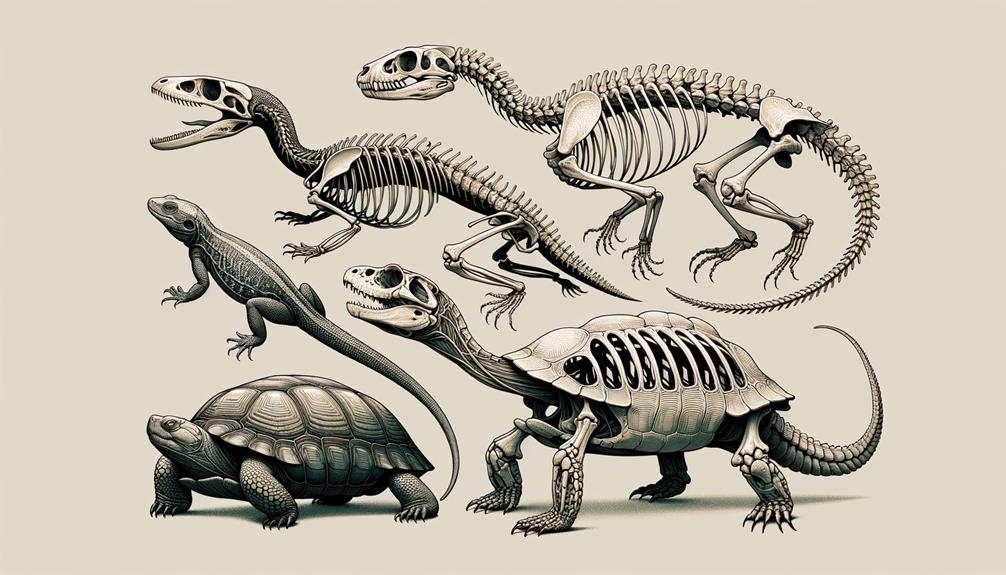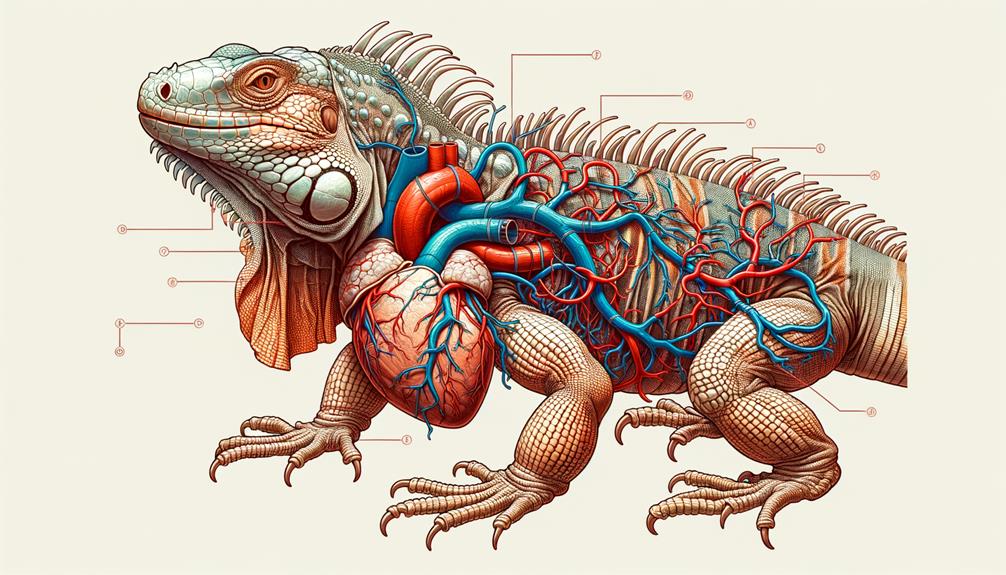I've always been fascinated by the respiratory systems of reptiles, which have evolved to thrive in diverse habitats. Their lungs have numerous pockets, increasing surface area for efficient gas exchange. Reptiles breathe using buccal pumping and costal aspiration, techniques inherited from amphibians and adapted for air intake through rib movements. Crocodilians have developed a unique liver-like piston mechanism to enhance lung ventilation, while snakes have a single, elongated lung suited for swallowing large prey. Despite having three-chambered hearts, these adaptations enable reptiles to survive and flourish. To better understand how these mechanisms support their survival, let's examine specialized adaptations and comparative physiology in more detail.
Key Takeaways
Reptilian lungs boast numerous epithelium pockets, increasing the surface area for efficient gas exchange. To ventilate effectively, reptiles employ buccal pumping and costal aspiration mechanisms. A unique feature of crocodilians is their liver-like piston mechanism, which boosts air exchange efficiency. Snakes, on the other hand, have a single, elongated lung and rely heavily on buccal pumping, especially during feeding. These respiratory adaptations have enabled reptiles to thrive in diverse terrestrial and aquatic environments.
Reptilian Lung Structure
Reptilian lungs are incredibly efficient, thanks to their intricate structure featuring numerous pockets in the lung epithelium. This unique design greatly increases the surface area available for gas exchange, surpassing the efficiency of amphibian lungs. As a result, reptiles can thrive in various environments.
The pockets in the lung epithelium, similar to alveoli, vastly increase the surface area for gas exchange. This specialized design enables reptiles to maximize oxygen intake and carbon dioxide expulsion with each breath. In contrast, amphibians have simpler lungs that limit their efficiency.
Reptiles' lung structure is adapted to support their active lifestyles and diverse habitats. For example, snakes have modified single lungs to accommodate swallowing large prey, while crocodilians use their liver-like piston for ventilation. Each species has evolved its lung structure to meet its specific needs, showcasing the remarkable adaptability of reptiles.
Ventilation Mechanisms
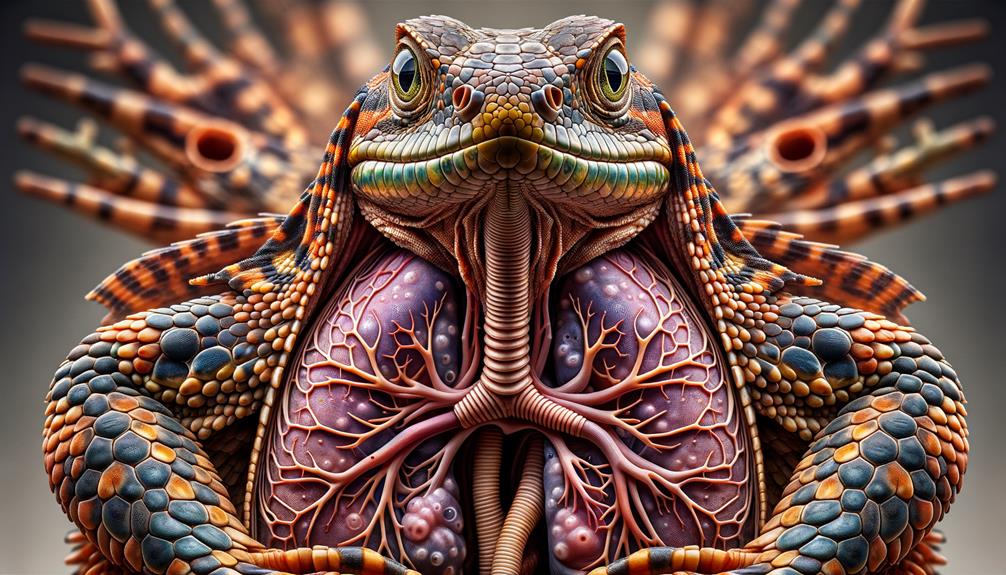
The ventilation mechanisms in reptiles, including buccal pumping and costal aspiration, showcase a remarkable evolutionary strategy to maximize respiratory efficiency. By combining these methods, reptiles effectively boost their breathing capabilities. Buccal pumping, inherited from amphibians, involves the rhythmic movement of the throat to draw air into the lungs. However, reptiles have largely shifted to costal aspiration, which uses rib movements to expand the pleura-peritoneal cavity, drawing air away from the external environment and into the lungs.
This shift marks a significant adaptation, favoring life on land where efficient oxygen intake is crucial. Snakes, for example, have adapted their single lung to accommodate the swallowing of large prey, a process that demands a specialized breathing mechanism. The increased surface area for oxygen absorption in reptile lungs, achieved through pockets in the lung epithelium, further highlights their respiratory efficiency.
These adaptations, including the critical role of rib movements, help reptiles compensate for the limitations posed by their three-chambered hearts. Through these mechanisms, reptiles maintain effective gas exchange, ensuring they can thrive in diverse environments. The sophisticated interplay of these breathing strategies underscores the remarkable flexibility of reptilian respiratory systems.
Adaptations in Crocodilians
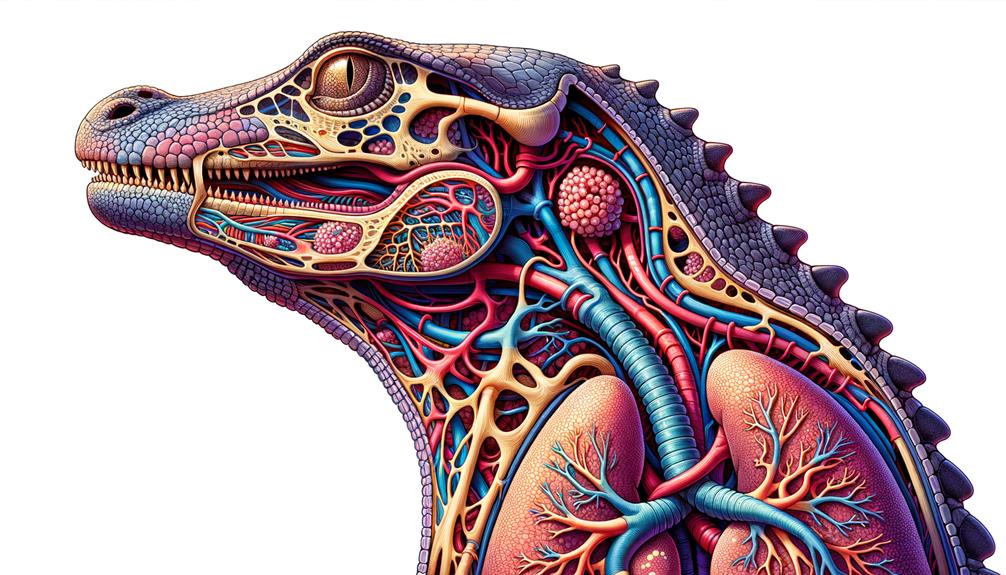
Crocodilians have evolved a highly specialized respiratory system that sets them apart from other reptiles. Their unique liver-like piston mechanism, controlled by the diaphragm muscle, allows for more efficient air exchange and better lung ventilation. This adaptation enables them to breathe more effectively, giving them a significant advantage in their environment.
The respiratory system of crocodilians is complex, featuring a trachea, bronchi, and lungs with a greater surface area for gas exchange than other reptiles. This increased surface area supports their higher metabolic rate and activity levels, which are essential for their survival in various habitats.
One of the most remarkable aspects of crocodilian respiratory adaptations is their ability to hold their breath for extended periods. This is crucial during activities like diving or aggressive displays, where conserving oxygen is vital. The efficiency of their respiratory system allows them to maximize oxygen intake and sustain themselves during these prolonged periods.
In essence, the advanced respiratory system of crocodilians not only enhances their breathing efficiency but also supports their dynamic lifestyle.
Snake Respiratory System
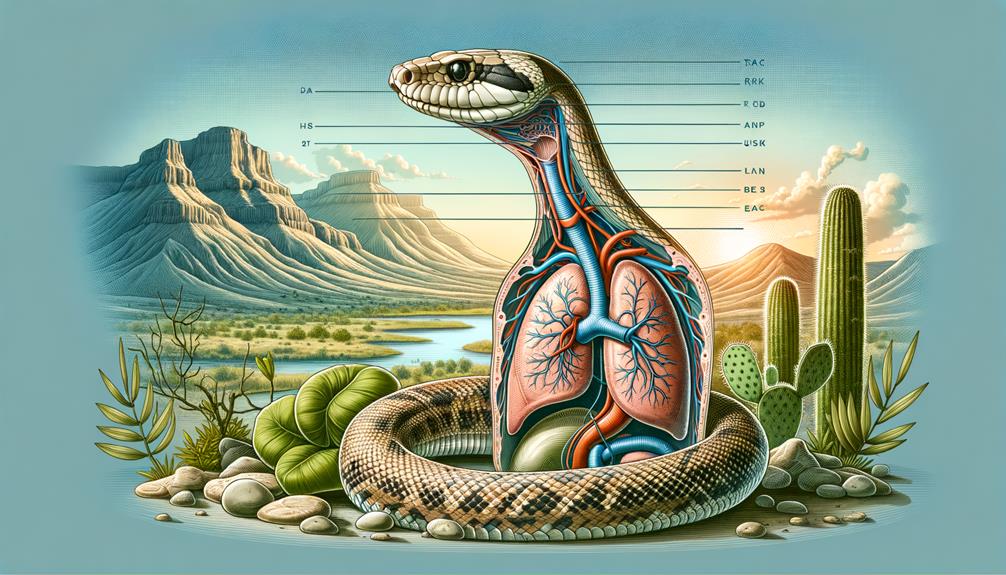
Snakes have a unique respiratory system that sets them apart from other animals. Their single, elongated lung and rudimentary trachea are key to their distinctive physiology and feeding behavior. Unlike mammals, which have complex and bilaterally symmetrical lungs, snakes have simpler and asymmetrical lungs. The primary lung is sac-like with fewer air sacs, which limits its capacity for efficient gas exchange.
To compensate for this, snakes rely heavily on a buccal pump mechanism to drive airflow. By contracting their mouth and throat muscles, they force air in and out of their lungs, making up for the lack of a diaphragm. This adaptation is crucial during feeding, as the elongated lung can shift to accommodate large prey, allowing snakes to breathe continuously.
However, this unique system comes with trade-offs. Without a diaphragm, snakes rely on the buccal pump to breathe, which is less efficient than the diaphragm-driven airflow seen in mammals. This limits their ability to sustain high-intensity activities for extended periods. Despite this, the snake's respiratory system is a remarkable example of adaptation, highlighting the diversity of respiratory systems in the animal kingdom.
Comparative Physiology

Examining the respiratory systems across various reptilian taxa reveals fascinating adaptations that balance the demands of both terrestrial and aquatic environments. Some reptiles have evolved lungs with complex structures to maximize the surface area for absorbing oxygen. This evolution of lungs is particularly evident when comparing species that thrive in different habitats.
Reptiles rely on both buccal pumping and costal aspiration for breathing. Buccal pumping involves the throat muscles pushing air into the lungs, while costal aspiration uses the expansion and contraction of the rib cage. Despite their three-chambered hearts, which result in less efficient blood circulation compared to birds and mammals, reptiles have adapted in remarkable ways to optimize their respiratory efficiency.
Here's a comparative overview of key respiratory adaptations in different reptilian groups:
| Taxa | Respiratory Mechanism | Habitat Adaptation |
|---|---|---|
| Snakes | Costal Aspiration | Terrestrial and Arboreal |
| Turtles | Buccal Pumping & Lungs | Aquatic and Semi-aquatic |
| Crocodilians | Costal Aspiration | Aquatic with extended breath-holding |
| Lizards | Costal Aspiration | Varied: terrestrial, arboreal |
Each group exhibits unique adaptations, illustrating the evolutionary diversity among reptiles. By understanding these mechanisms, we gain insight into how these creatures have mastered the art of absorbing oxygen efficiently in their respective environments.
In general, reptiles have developed remarkable respiratory systems that enable them to thrive in diverse habitats. From the intricate lungs of snakes to the dual respiratory systems of turtles, each adaptation is a testament to the incredible flexibility of reptilian physiology. By exploring these adaptations, we can appreciate the remarkable diversity of reptilian life.
Frequently Asked Questions
What Type of Respiratory System Do Reptiles Have?
Reptiles have a unique respiratory system that relies on lungs for gas exchange. To breathe, they use a combination of buccal pumping and costal aspiration. Their lung structure is adapted to support both aerial and aquatic respiration, which complements their three-chambered heart.
What Is the Process of Respiration in Reptiles?
When explaining respiration in reptiles, I highlight that they use a combination of buccal pumping and costal aspiration. Their lungs have a complex structure with specialized mechanisms that facilitate efficient gas exchange, allowing them to thrive in terrestrial environments.
Do Reptiles Breathe With Lungs or Gills?
breathe with
What Is the Respiratory System of a Snake?
A snake's respiratory system is quite remarkable. It has one long lung, with the right one being more efficient. The snake's rib movements and an aspiration pump work together to breathe, allowing it to exchange gases efficiently, even when swallowing large prey.


